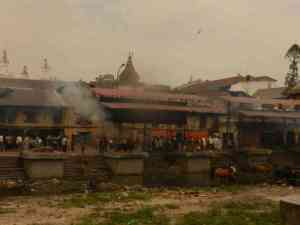 |
| Place of the Dead. |
Pashupati in Kathmandu is hard to get out of your head if you are bold enough to go there. It is considered the holiest Hindu site because its where the dead are cremated before all to see. It’s called an Arya Ghat and is where Hindus only are buried. In India, apparently, you are a Hindu or you are Dravid. I don’t know how the Dravid deal with dead bodies. But my sharp guide Ramesh said that cremation beside this holy river (which looked like a dried up dump where cattle (holy folk) wander and dogs pick through food scraps) purifies the soul of the dead, the body to be tossed in it once the ashes are ashes again.
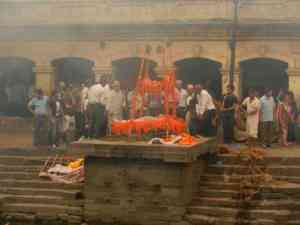 |
| Cremation of a woman |
There is a familiarity of the way families and friends are standing around watching the cremator prepare the funeral pyre and also to not offend the fragile moments. When I was there yesterday, five cremations were happening a bit staggard, each taking place on a small promatory that jutted out on the waterless river. When I was there four years ago, it had plenty of water but this season is dry. Smoke was thick coming from whatever stage of the burning. The newest was a large gathering and the pyre was decked in marigolds like some sort of bed throne. The body, wrapped in orange and white, was placed on the pyre and the fires lit. There is fainting and weeping and the family will start immediately 13 days of mourning when the male members and the wife or mother wear white (daughters do not have to do this) and are shut up in a space at the Pashupati for the duration. Men shave their heads on the spot (there is a barber to assist), take a bath (hopefully not in the riverette below) and then begin the period of solace with their families.
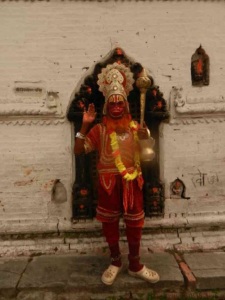 |
| Holy Hindu for a price. |
Ramesh told me there are four ways of disposing of the body. First is cave burial for the holy men who meditate in and confine themselves to caves. These are the Shadu, like those wandering around Pashupati painted white with orange touches and hardly any clothing, renouncing all that has to do with “samsada” or the material way of life. The real aim of all is to remove themselves from “samsada”. To what degree one succeeds, then Shiva, the major god of Hinduism, determines what kind of life one is to have in the next life. There is a Judgement Day, sort of, when what we do in our lives is measured to establish where one goes next. Maybe you can be a water buffalo or you might just remain in the same old cast level you had this time.
Ok, the second kind of burial is water burial. This is particularly for children under age of 8. They are wrapped in a cloth and float down the Ganges. They are not cremated because children are pure and sinless. That’s a reverse from our Christian concept that we are all born in sin and have to be baptized with holy water ASAP to have that sin removed and to start a clean life. Interesting is the similar value of water in these religious activities. Also the bodies of the Shadu are similarly wrapped (after they die in the cave, I guess) to float down the Ganges. The Ganges, dirty as it is, is the most holy of rivers. But the Shadu, who don’t look so clean in life, are clean, having overcome all evil tendencies,
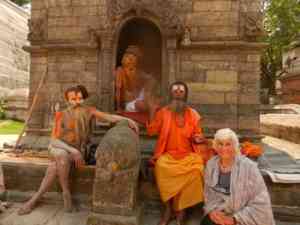 |
| Me and the holy Shadu. |
The third burial is cremation, which is all around us. It is the most recognized and scientific. Ninety-five per cent of Hindi are cremated, except children, Shadu, pregnant women, and those with epidemic diseases, like AIDS, yellow fever, malaria, etc. It’s point is to detach the soul from the flesh. One goes to the stars, the other to the river.
The fourth burial is sky burial. This is designated for those with epidemic diseases. If the evil spirits see fire on the epidemic carrier then it makes the angry and cause havoc.
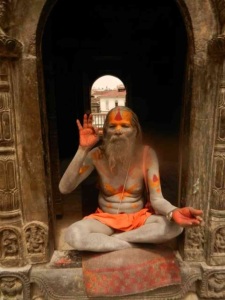 |
| Orange is God’s color. |
Another interesting element of this is that a body is cremated within in 2-6 hours of death. The theory here is the eternal soul and body are one at the time of death. They are eternal friends. Until the soul sees its friend lying on the floor (I guess reclined body is important) it cannot go away until the body is destroyed. When the soul sees no more friend, then it flies away to heaven and can live in peace. Sky burial I discussed before as a Buddhist option when the monk divides up the body and leaves it for the vultures.
All of this has stirred my soul since my brother and mother were cremated. My brother’s ashes are in the power of his widow. My mother’s ashes are in a beautiful emerald green urn interned next to my father in a cemetery. Ours was a more private and dignified celebration of the life of a great lady. There was time to prepare, there was prayer, there was a coming together of family to share and morn, there was a visitation of friends from her life and the lives of her heirs and there was a feeling of peace. I still do not know how I feel about cremation but in this ever crowded and almost untrustable world, there is a rhythm to life and death and what we do to our bodies here on earth can be washed away so that our souls are free to meet again all those who have loved us and whom we have loved as we journey to the Heavenly Kingdom of our Father God. Those who love are sured there are great arms waiting to hold us in the afterlife. God bless.
 |
| Orange on everything. |

Audrey,
Love the picture of you with the Shadu.
Their burials appear to get pretty complicated. What in the world happens to the bodies that are left to float in Ganges?
You are a wordsmith and really have a way of explaining everything. Thank you for sharing your adventure with us.
We are praying for you and your safe return home.
We love you and miss you,
Geraldean and Judge